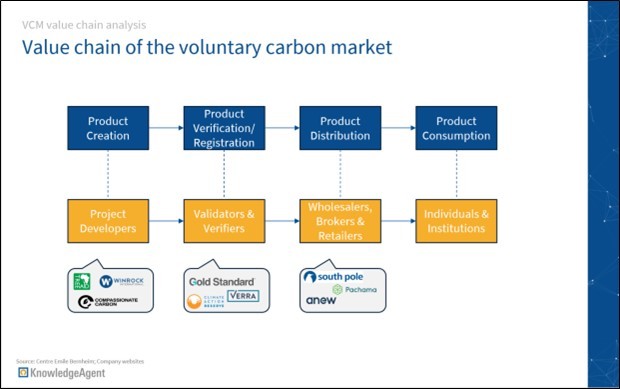Net-zero targets are now a top priority for many companies. The number of listed companies aiming for net zero has more than doubled from 417 in 2020 to 929 in 2023. For most companies, however, it is not possible to completely avoid CO2 emissions, which is where carbon credits come in.
The importance of voluntary carbon markets
While compliance or mandatory carbon markets, such as the EU Emissions Trading System, are regulated by mandatory national, regional, or international carbon reduction regime, voluntary carbon markets allow companies to voluntarily offset their carbon footprint by purchasing carbon credits. The idea behind carbon credits is that credit providers implement projects that avoid or remove CO2 from the air. Such projects can be divided into four categories:
- Avoided nature loss (including deforestation)
- Nature-based sequestration (e.g., reforestation)
- Emissions avoidance or reduction (e.g., methane from landfills)
- Technology-based removal of carbon dioxide from the atmosphere
Companies can then invest in those projects and receive certificates called carbon credits in return to offset their own emissions, with one carbon credit equivalent to the removal of one tonne of atmospheric CO2 emissions. In 2021, 332 million of these credits were purchased when a record number of companies set carbon-reduction goals. McKinsey estimates the global demand for voluntary carbon credits could increase by a factor of 15 by 2030.
How does the market work?
To understand how the voluntary carbon market works, let's take a closer look at its value chain. The voluntary carbon market's value chain encompasses various stages, each involving different types of companies. In the following chart, we illustrate the key components of this value chain, along with exemplary providers.

Depending on their position in the supply chain, carbon credit sellers can be categorized into four main levels:
- Project developers, who develop GHG offset projects and sell carbon credits to aggregators, retailers, or final customers
- Wholesalers, who own a portfolio of emissions credits and only sell offsets in bulk
- Retailers, who own a portfolio of emissions credits and sell small amounts to individuals or organizations
- Brokers, who do not own emissions credits but facilitate transactions between sellers and buyers
It is worth noting that sellers frequently operate in more than one category type. Additionally, there are independent or accredited third-party verifiers responsible for product verification, as well as institutions and final consumers participating in the market.
The following examples represent a few interesting research areas and case studies related to the voluntary carbon market our team has worked on.
Market scans
One of our clients recently aimed to find operators to help him implement carbon offset projects in specific geographic regions.
Leveraging its expertise, the KnowledgeAgent team has compiled a long-list of companies operating across different stages of the value chain, as well as their specific project focus, the technologies the providers use and press reviews, with a particular focus on the geographical regions in which they operate. The market scan enabled the client to identify the optimal carbon offset partner to drive their sustainability strategy ahead.
Deep dives
Our client aimed to understand the product development journey of different operators in the voluntary carbon market.
To gain deeper insight into the services provided by carbon market participants, we have examined the value chains of selected players of interest, highlighting the technologies used at each step of the value chain. We have identified the following steps that the value chain of a carbon credit developer may include:
- Project scoping
- Concept development
- Feasibility assessment
- Building of an investment case
- Securing funding
- Implementation & certification
How much money is the market attracting?
In another project, we were asked to research the market development and specific deal sizes of the carbon removal market.
As more and more companies pledge to help stop climate change by reducing and offsetting their own CO2 emissions, the value of the carbon market has been increasing. While the market was worth
USD 2 bn in 2021, it is expected to reach between USD 10-40 bn by 2030. To provide further detail on the deals in the market, we have identified specific deal sizes for corporate investment in carbon credits to provide our client with an up-to-date overview of market activity.
How can KnowledgeAgent help your company?
KnowledgeAgent is increasing its expertise in this important and thriving market, assisting both businesses to reduce their carbon footprint and developers or verifiers to establish in the market. Whether you aim to identify carbon offset project developers, would like to benchmark providers based on specific criteria, or find out carbon credit strategies of your competitors, KnowledgeAgent provides you with detailed research and analysis.
Sources:
-
AP News, 12/06/2023, More companies setting ‘net-zero’ climate targets, but few have credible plans, report says, https://www.mckinsey.com/capabilities/sustainability/our-insights/a-blueprint-for-scaling-voluntary-carbon-markets-to-meet-the-climate-challenge, accessed 30/11/2023
-
McKinsey, 29/01/2023, A blueprint for scaling voluntary carbon markets to meet the climate challenge, https://www.mckinsey.com/capabilities/sustainability/our-insights/a-blueprint-for-scaling-voluntary-carbon-markets-to-meet-the-climate-challenge, accessed 30/11/2023
-
BCG, 19/01/2023, The Voluntary Carbon Market Is Thriving, https://www.bcg.com/publications/2023/why-the-voluntary-carbon-market-is-thriving, accessed 30/11/2023
-
Deloitte, 04/07/2023, Understanding the Compliance and Voluntary Carbon Trading Markets, https://www2.deloitte.com/uk/en/blog/risk-powers-performance/2023/understanding-the-compliance-and-voluntary-carbon-trading-markets.html, accessed 04/12/2023
-
ULB, 01/2012, Regulated (CDM) and voluntary carbon offset schemes as carbon offset markets: competition or complementarity?, https://www.researchgate.net/publication/254450839_Regulated_CDM_and_voluntary_carbon_offset_schemes_as_carbon_offset_markets_competition_or_complementarity, accessed 01/12/2023

